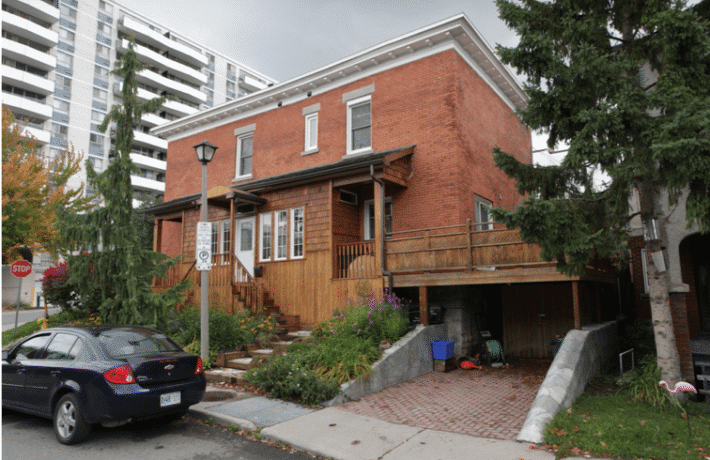
Ottawa grew rapidly around the turn of the century (the population increased 60% between 1891 and 1901, 45% between 1901 and 1911), and investors began to show interest in a central area that had been bypassed by development- Lower Town. In 1905-1907, a large lot in Lower Town was re-assembled by Sir Charles Fitzpatrick, Chief Justice of the Supreme Court of Canada, most famous as defence counsel for Louis Riel during his trial for treason in 1885. Fitzpatrick held the assembled property for only a year before selling to J. Alfred Gendron for $5,000, a price that included leases or ownership of houses on Wurtemburg and Heney Streets. Lot 17 was to serve as a revenue property for non-resident owners until 1952. We’ll trace the ownership of the house first, then return to look at its residents.
A notice of the Gendrons 50th wedding anniversary in 1914 described him a “pioneer merchant in the bicycle industry in Toronto” who retired to Ottawa, presumably about the time he bought the property (Journal 1914-08-05 p 9) Gendron moved quickly to demolish all the houses on the Wurtemburg side of the lot, as well as no 89 Heney, and to replace them with the present four-door row at 114-120 Wurtemburg: he and his wife moved into no 120, on the corner of Heney. He also built the present house at 524 Clarence/102 Wurtemburg, but it is unclear what he built, or exactly when.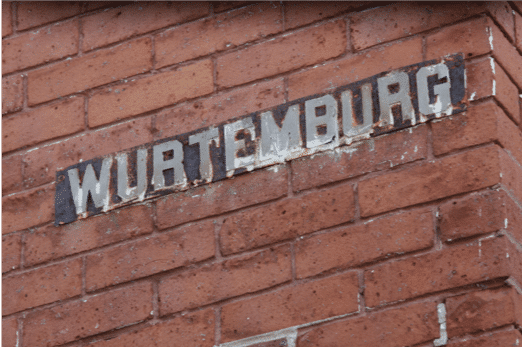
The City Directory listed the corner as “vacant” until the edition for 1916 (with information collected in 1915), which listed a single house at 102 Wurtemburg Street with the note “new house, vacant”. Only the single address, 102 Wurtemburg was listed in subsequent editions.
However, the Fire Insurance map of 1912 shows what is clearly the current house, labeled as a two-storey semi-detached frame house with a flat tar-and-gravel roof, brick facing, porches front and rear, divided east/west, labelled as 522 Clarence and 4 (i.e. 104) Wurtemburg, with a fence dividing the two yards and a one-storey shed or stable on the 522 side. It looks like a standard semi-detached house of the period, with doors for both units facing Clarence Street, a symmetrical arrangement of windows, and no firewall between the two halves (giving an address on one street when the door faced the other street was not unusual for corner properties on the fire insurance maps of the time).
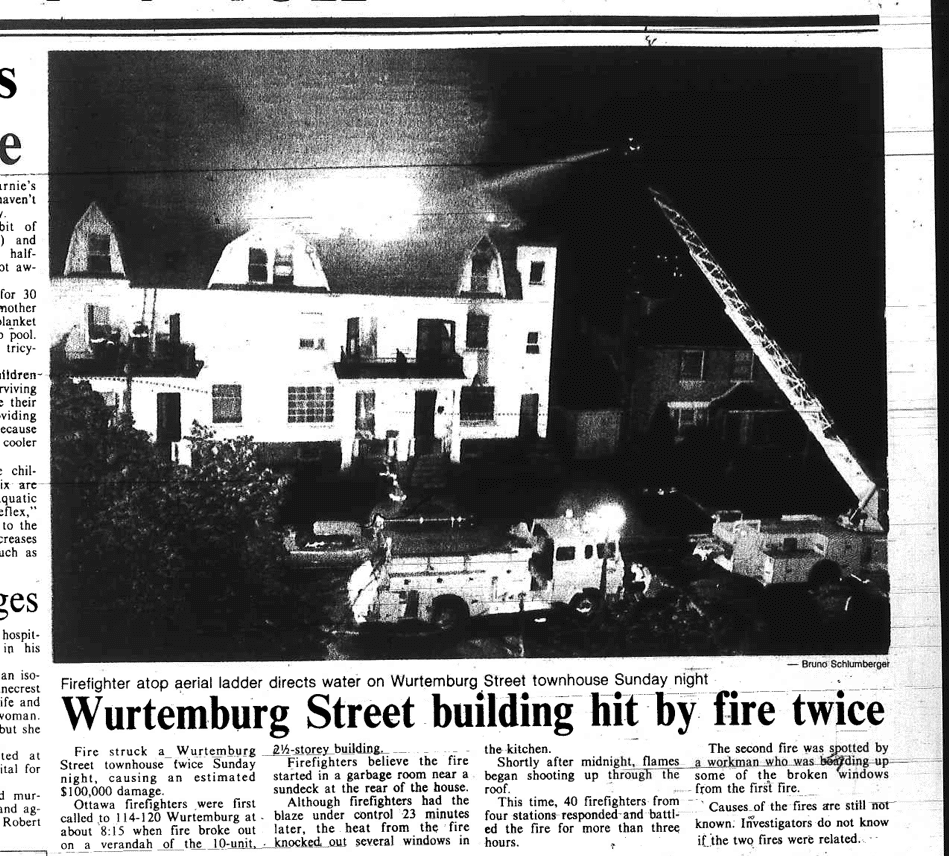
Did Gendron build a semi-detached house and then change his mind before renting it out? Did he build a single house and then later add on a second unit (some sheets of the insurance plan were revised in 1915)? The panel of contrasting colour under the ground-floor window of 524 that faces Wurtemburg Street could indicate that this was once a doorway (or be the sign of major repairs required by leaking window).
Gendron died in 1920, and his widow sold lot 17 for $8,000 to a syndicate of real-estate investors from Montreal and Ottawa who also owned a part interest in lot 16 (516-520 Clarence). This would have been a package deal for 102 and 114-120 Wurtemburg, one or more houses on Heney Street and possibly 106 Wurtemburg. In 1925 the syndicate mortgaged the north and south halves of the property separately: 102.88 feet south from the corner of Wurtemburg and Clarence, along with 102 and possibly 106 Wurtemburg to Joseph G. Pigeon, a civil servant who lived on Sweetland Avenue, and the remaining 90 feet with 114-120 Wurtemburg and the houses on Heney Street to the Huron and Erie Mortgage Co.
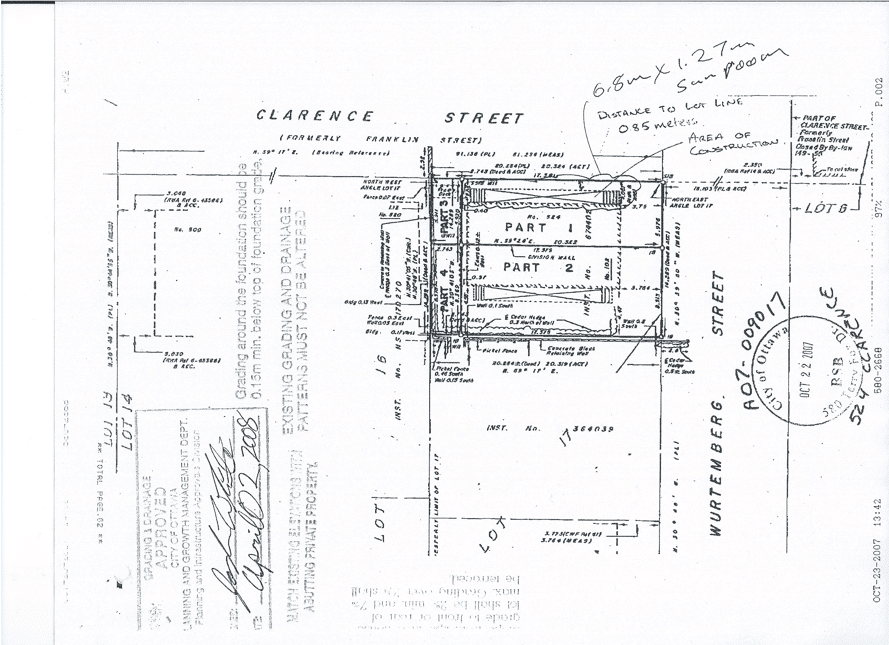
We don’t know what other properties the syndicate owned (other than the part interest in 520 Clarence), but they were badly affected by the Depression. In 1932 and 1937 they walked away from their two mortgages, and Pigeon ended up owning all of lot 17. Pigeon sold the north half of the lot, with 102 and 106 Wurtemburg, in 1940 for $3,100 to a family called Schindler or Shindler, and in 1942 sold the south half with 114-120 Wurtemburg and the houses on Heney Street to a family called Archambault.
With the Schindlers, 524/102 began to take the shape familiar today. They immediately divided 102 Wurtemburg into two units, creating 524 Clarence as a separate dwelling, and in 1943 they split the lot, keeping 106 Wurtemburg and a plot 56 x 66 feet, but selling 524/102 and a plot 46.88 x 66 for $5,150 to Henry Moore, a landlord who had lost a half-interest in 520 Clarence to the mortgage company in 1937. Moore died in 1946 and his executors sold 524/102 to Steve Pentiseule for $5,500. Pentiseule in turn sold in 1952 to Lionel Lanthier for $9,700. Lanthier, a bus driver/streetcar motorman for the Ottawa Transportation Commission, was the first owner of 524/102 actually to live in the house.
With the 1920s, Lowertown east had finally built up. With the departure of the hospitals, factories and workshops and the laying out of parks and playgrounds, the area had become a pleasant place to live. Two contrasting neighbourhoods met in the area around Macdonald Gardens: Lowertown, strongly catholic and francophone, and Sandy Hill, somewhat wealthier, with many civil servants and academics, and unusual in old Ottawa for being mixed ethnically and religiously. The list of residents in 102 Wurtemburg and 524 Clarence reflects the influence of both neighbourhoods.
The first recorded tenant in 102 Wurtemburg (1916-1925) was Lionel Boisvert, an engineer for the Canadian National Railways, probably based at the engine terminal at Mann Avenue and Nicholas Street. After standing vacant for two years, the house was rented 1928-32 by Errol Bouchette, a stenographer in the Department of Agriculture and his wife Alice. Bouchette was the son of Robert-Errol Bouchette (1862-1912), Ottawa native, lawyer, journalist, civil servant, campaigner for the modernization of French-Canadian society and a leading intellectual of his day. The Bouchettes were succeeded by Gerald and Constance Ballard (1933); Ralph Field, a clerk in the Department of National Defence, and his wife Edna (1935-38) and Rufus Parent, a medical doctor, and his wife Adèle (1939).
Another notable family followed in 1941-42: Arthur Godbout (1908-1985), at the time a master in the Normal School of the University of Ottawa (the French-language teachers’ college for Ottawa). He had been a high school teacher in Ottawa, Sudbury and Kirkland Lake, and returned to Sudbury in 1943 as a school inspector. He resumed his position at the Normal School in 1945, where he became noted for his work in improving the quality of education in the French schools of Ontario. When the English and French Normal Schools merged to form the Faculty of Education at the University of Ottawa, Godbout became one of its first professors. In his later years he was a prolific author of books, articles and journalism, and active internationally in organization related to education. Arthur’s wife Noella outlived him, dying in 2005 at the age of 90.
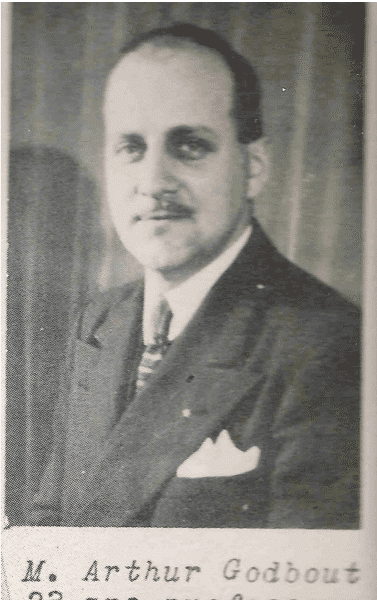
The Godbouts were followed by Robert Laliberté and his wife Aline (1943). Laliberté was a travelling salesman for the Rock City Tobacco Co. Ltd, a Quebec City company that made the brands of its British parent Carriere’s for the Canadian market: Black Cat, Craven A, Sportsman and others. (Through mergers, Rock City is now part of Rothmans, Benson and Hedges, which still operates the Quebec City factory.). Aline Clyne rented 102 Wurtemburg in 1944, joined by her husband Orville on his return from active wartime duty to a job at the Post Office. Orville stayed in 102 until 1959, but after 1954 his wife is listed as Gretta.
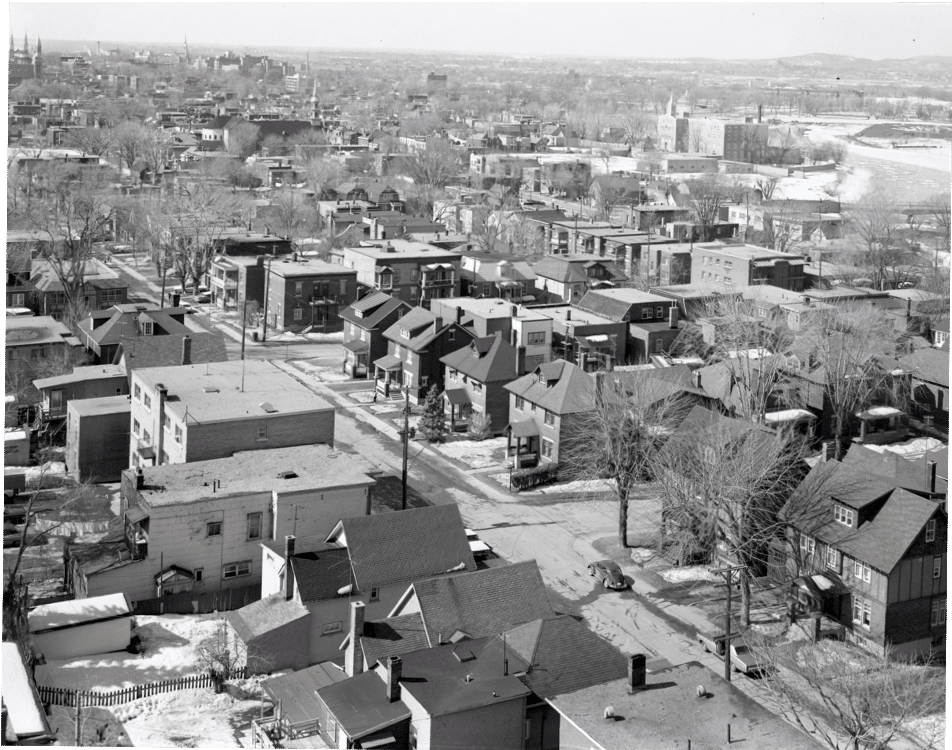
The first recorded tenants in 524 Clarence were Percy Carrière, a car dealer, and his wife Anita (1941-1949). The house was vacant until Lionel Lanthier moved in in 1951, initially it seems as a tenant, but from 1952 as owner. In 1959 he sold vacant possession of 524/102 to Paul Menard, a machinist at National Brake and Clutch on Wellington Street and his wife Noella for $14,000.
Like other central neighbourhoods, by the 1950s housing in the area was run down after the tight money of the Depression and the war years. The new, planned postwar suburbs offered quality housing at cheaper prices and with easier financing than established neighbourhoods, and more cars and suburban growth made Charlotte Street a major through road.
The City’s review of housing stock in 1958 rated 524/102 along with the rest of the block as in “poor” condition (on a four-point scale from “good” to “very poor”). A subsequent policy review (1962) considered that no intervention was needed as it was once again fashionable to live in a central neighbourhood, and new owners were already renovating existing houses or replacing them with denser development.
A number of spin-offs from the Lower Town East urban renewal project of the 1970s benefitted the area immediately around Clarence and Wurtemburg, including renewed community facilities, closure of the the roadway through the middle of Macdonald Gardens, and the closing off of Charlotte and Clarence Streets to through traffic (the origin of the “East” in Clarence Street East). Another renovation of Macdonald Gardens, including reconstruction of the summerhouse, is underway now to mark the park’s 100th anniversary (August 2014). Although 524/102 must have gone through major repairs and renovations during this period, we have been unable to trace the actual dates or the work done.